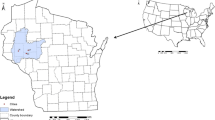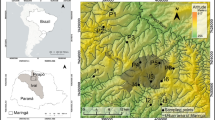Abstract
Monitoring changes in land cover and the subsequent environmental responses are essential for water quality assessment, natural resource planning, management, and policies. Over the last 75 years, the Lake Issaqueena watershed has experienced a drastic shift in land use. This study was conducted to examine the changes in land cover and the implied changes in land use that have occurred and their environmental, water quality impacts. Aerial photography of the watershed (1951, 1956, 1968, 1977, 1989, 1999, 2005, 2006, and 2009) was analyzed and classified using the geographic information system (GIS) software. Seven land cover classes were defined: evergreen, deciduous, bare ground, pasture/grassland, cultivated, and residential/other development. Water quality data, including sampling depth, water temperature, dissolved oxygen content, fecal coliform levels, inorganic nitrogen concentrations, and turbidity, were obtained from the South Carolina (SC) Department of Health and Environmental Control (SCDHEC) for two stations and analyzed for trends as they relate to land cover change. From 1951 to 2009, the watershed experienced an increase of tree cover and bare ground (+17.4 % evergreen, +62.3 % deciduous, +9.8 % bare ground) and a decrease of pasture/grassland and cultivated land (−42.6 % pasture/grassland and −57.1 % cultivated). From 2005 to 2009, there was an increase of 21.5 % in residential/other development. Sampling depth ranged from 0.1 to 0.3 m. Water temperature fluctuated corresponding to changing air temperatures, and dissolved oxygen content fluctuated as a factor of water temperature. Inorganic nitrogen content was higher from December to April possibly due to application of fertilizers prior to the growing season. Turbidity and fecal coliform bacteria levels remained relatively the same from 1962 to 2005, but a slight decline in pH can be observed at both stations. Prior to 1938, the area consisted of single-crop cotton farms; after 1938, the farms were abandoned, leaving large bare areas with highly eroded soil. Starting in 1938, Clemson reforested almost 30 % of the watershed. Currently, three fourths of the watershed is forestland, with a limited coverage of small farms and residential developments. Monitoring water quality is essential in maintaining adequate freshwater supply. Water quality monitoring focuses mainly on the collection of field data, but current water quality conditions depend on the cumulative impacts of land cover change over time.








Similar content being viewed by others
References
Allan, J. D. (2004). Landscapes and riverscapes: the influence of land use on stream ecosystems. Annual Review of Ecology, Evolution, and Systematics, 35, 257–284.
Bakr, N., Weindorf, D. C., Bahnassy, M. H., Marel, S. M., & El-Badawi, M. M. (2010). Monitoring land cover change in a newly reclaimed area of Egypt using multi-temporal Landsat data. Applied Geography, 30, 592–605.
Cabe, K. (2014). Southern pine beetle fact sheet. Available on-line at http://www.state.sc.us/forest/refspb.htm (last accessed on June 13, 2014).
Choi, M., & Han, S. (2013). Remote sensing imageries for land cover and water quality dynamics on the west coast of Korea. Environmental Monitoring and Assessment, 185(11), 9111–9124. doi:10.1007/s10661-013-3240-1.
Cihlar, J., & Jansen, L. J. M. (2001). From land cover to land use: a methodology for efficient land use mapping over large areas. Professional Geographer, 53, 275–289.
Comber, A. J. (2008). The separation of land cover from land use using data primitives. Journal of Land Use Science, 3, 215–229.
Corner, R.J., Dewan, A.M., & Chakma, S. (2014). Monitoring and prediction of land-use and land-cover (LULC) change. Dhaka Megacity: Geospatial Perspectives on Urbanization, Environment and Health (Dewan, A., & Corner, R., eds.). Book Series: Springer Geography. Pp. 75-97.
Coulter, C., Kolka, R., & Thompson, J. (2004). Water quality in agricultural, urban, and mixed land use watersheds. Journal of the American Water Resources Association, 40(6), 1593–1601. doi:10.1111/j.1752-1688.2004.tb01608.x.
Dean, A. M., & Smith, G. M. (1993). An evaluation of per-parcel land cover mapping using maximum likelihood class probabilities. International Journal of Remote Sensing, 24, 2905–2920.
Dewan, A. M., & Yamaguchi, Y. (2008). Effect of land cover changes on flooding: example from Greater Dhaka of Bangladesh. International Journal of Geoinformatics, 4, 11–20.
Dewan, A. M., & Yamaguchi, Y. (2009a). Using remote sensing and GIS to detect and monitor land use and land cover change in Dhaka Metropolitan of Bangladesh during 1960-2005. Environmental Monitoring and Assessment, 150, 237–249.
Dewan, A. M., & Yamaguchi, Y. (2009b). Land use and land cover change in Greater Dhaka, Bangladesh: using remote sensing to promote sustainable urbanization. Applied Geography, 29, 390–401.
Galang, M. A., Markewitz, D., Morris, L. A., & Bussell, P. (2007). Land use change and gully erosion in the Piedmont region of South Carolina. Journal of Soil and Water Conservation, 62, 122–129.
Halstead, J. A., Kliman, S., White Berheide, C., Chaucer, A., & Cock-Esteb, A. (2014). Urban stream syndrome in a small, lightly developed watershed: a statistical analysis of water chemistry parameters, land use patterns, and natural sources. Environmental Monitoring Assessment, 186, 3391–3414.
Jansen, L. J. M., & Di Gregorio, A. (2002). Parametric land cover and land-use classifications as tools for environmental change detection. Agriculture, Ecosystems and Environment, 91, 89–100.
Kalyanapu, A., Hossain, A., Kim, J., Yigzaw, W., & Hossain, F. (2013). Toward a methodology to investigate the downstream flood hazards on the American river due to changes in probable maximum flood due to effects of artificial reservoir size and land-use/land-cover patterns. Earth Interactions, 17. doi: 10.1175/2012EI000496.1
Kamusoko, C., Aniya, M., Adi, B., & Manjoro, M. (2009). Rural sustainability under threat in Zimbabwe—simulation of future land use/cover changes in the Bindura district based on the Markov-cellular automata model. Applied Geography, 29, 435–447.
Li, J., Feng, P., & Wei, Z. (2013). Incorporating the data of different watersheds to estimate the effects of land use change on flood peak and volume using multi-linear regression. Mitigation and Adaptation Strategies for Global Change, 18(8), 1183–1196. doi:10.1007/s11027-012-9416-0.
Lin, Y., Hong, N., Wu, P., Wu, C., & Verburg, P. H. (2007a). Impacts of land use change scenarios on hydrology and land use patterns in the Wu-Tu watershed in northern Taiwan. Landscape and Urban Planning, 80(1–2), 111–126. doi:10.1016/j.landurbplan.2006.06.007.
Lin, Y., Hong, N., Wu, P., & Lin, C. (2007b). Modeling and assessing land-use and hydrological processes to future land-use and climate change scenarios in watershed land-use planning. Environmental Geology, 53(3), 623–634. doi:10.1007/s00254-007-0677-y.
Lin, Y., Lin, Y., Wang, Y., & Hong, N. (2008). Monitoring and predicting land-use changes and the hydrology of the urbanized Paochiao watershed in Taiwan using remote sensing data, urban growth models and a hydrological model. Sensors, 8(2), 658–680. doi:10.3390/s8020658.
Management Planning for the Clemson Experimental Forest. (2013). Clemson University (on-line access at http://www.clemson.edu/cafls/cef/documents/cef_mgt_plan_web_v1.pdf, verified on June 13, 2014).
Martinuzzi, S., Januchowski-Hartley, S. R., Pracheil, B. M., McIntyre, P. B., Plantinga, A. J., Lewis, D. J., & Radeloff, V. (2014). Threats and opportunities for freshwater conservation under future land use change scenarios in the United States. Global Change Biology, 20(1), 113–124. doi:10.1111/gcb.12383.
Mertens, B., & Limbin, E. F. (2000). Land-cover-change trajectories in Southern Cameroon. Annals of the Association of American Geographers, 90, 467–494.
Miranda, L. E., Andrews, C. S., & Kroeger, R. (2014). Connectedness of land use, nutrients, primary production, and fish assemblages in oxbow lakes. Aquatic Sciences, 76(1), 41–50. doi:10.1007/s00027-013-0310-y.
Mundia, C. N., & Aniya, M. (2006). Dynamics of landuse/cover changes and degradation of Nairobi City, Kenya. Land Degradation and Development, 17, 97–108.
National Climatic Data Center (NCDC). (2014). Long-term daily and monthly climate records from stations across the contiguous United States. Available on-line at http://www.ncdc.noaa.gov/sotc/national (last accessed on 06/13/14)
Sorrells, R. T. 1984. The Clemson Experimental Forest: its first fifty years. URL http://www.clemson.edu/cafls/cef/documents/50_years_cef.pdf [verified June 13, 2014].
South Carolina Department of Health and Environmental Control (SCDHEC). (2014). State of South Carolina Monitoring Strategy for Calendar Year 2014. http://www.scdhec.gov/HomeAndEnvironment/Docs/Strategy.pdf (last accessed on June 13, 2014).
Tefera, B., & Sterk, G. (2008). Hydropower-induced land use change in Fincha’a watershed, western Ethiopia: analysis and impacts. Mountain Research and Development, 28(1), 72–80. doi:10.1659/mrd.0811.
United States Department of Agriculture (USDA). (1950). Soil conservation services. Effects of soil conservation on sedimentation in Lake Issaqueena. By John J. Noll, John W. Roehl, and Jackson Bennett. Spartanburg, SC: Regional Water Conservation Division, 1950. Print. Available on-line at https://archive.org/details/effectsofsoilcon95noll (last accessed on June 13, 2014).
Wang, R., Xu, T., Yu, L., Zhu, J., & Li, X. (2013). Effects of land use types on surface water quality across an anthropogenic disturbance gradient in the upper reach of the Hun River, Northeast China. Environmental Monitoring Assessment, 185, 4141–4151.
Zhao, S., Da, L., Tang, Z., Fang, H., Song, K., & Fang, J. (2006). Ecological consequences of rapid urban expansion: Shanghai, China. Frontiers in Ecology and Environment, 4, 341–346.
Acknowledgments
Financial support was provided by Clemson University. The authors would like to thank Brian Ritter, of the Pickens County GIS office, for remote sensing data and GIS assistance. Data was provided by the USGS, USDA, and Pickens County GIS. Water quality data was provided by SCDHEC. Technical Contribution No. 6296 of the Clemson University Experiment Station. This material is based upon work supported by NIFA/USDA, under project number SC-1700452.
Author information
Authors and Affiliations
Corresponding author
Rights and permissions
About this article
Cite this article
Pilgrim, C.M., Mikhailova, E.A., Post, C.J. et al. Spatial and temporal analysis of land cover changes and water quality in the Lake Issaqueena watershed, South Carolina. Environ Monit Assess 186, 7617–7630 (2014). https://doi.org/10.1007/s10661-014-3953-9
Received:
Accepted:
Published:
Issue Date:
DOI: https://doi.org/10.1007/s10661-014-3953-9




